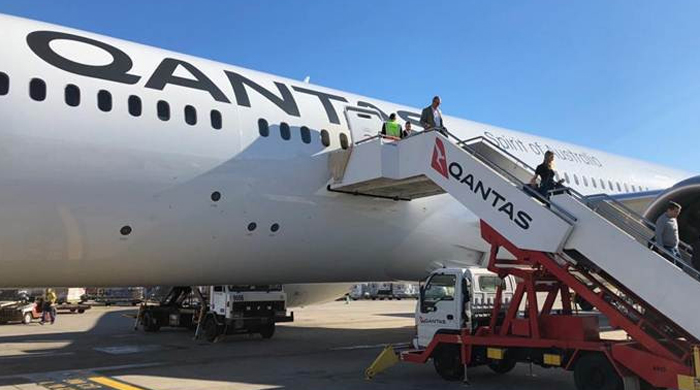
I just took the world's first 20-hour flight. Here's what it did to me

I've just endured the world's newest longest flight, a 16,200 kilometer (10,100 mile), nonstop ultra-marathon from New York to Sydney. It took about 19 and a half hours, and was almost as demanding as that sounds.
The record-breaking Qantas Airways Ltd. flight touched down early Sunday morning in Australia. The Boeing Co. Dreamliner delivered its few dozen passengers — including yours truly — to their destination more or less intact, even if some of us were not quite sure what day it was.
Qantas wants to begin flying the time-saving route commercially as soon as 2022, so the airline used this test trip to explore ways to reduce its inevitable downside: Soul-crushing, body-buckling jet lag. Here's how my journey unfolded in real time.
Our plane has just left JFK International Airport, and it's already become a flying laboratory. Since the goal is to adapt to our destination's time zone as fast as possible, we click into the Sydney clock right off the bat. That means no snoozing. The lights stay up and we're under instructions to stay awake for at least six hours — until it's evening in Australia.
This immediately causes trouble for some passengers.
Down one side of the business-class section, six Qantas frequent flyers are following a pre-planned schedule for eating and drinking (including limiting alcohol), exercise and sleep. They wear movement and light readers on their wrists and have been asked to log their activities; they've already been under observation for a few days and will be monitored for 21 days in total. Most of them are bingeing on movies or reading books, but one of them is dozing within minutes. To be fair, I feel his pain. It may be the middle of the day in Sydney, but my body is telling me it's pushing midnight back in New York.
Two Hours In
It's feeding time, and a key moment in the experiment. The specially designed dishes are supposed to fire me up, and a flavorful serving of poached prawns with chili and lime is like a gentle culinary slap in the face. Spicy Chinese-style cod with jasmine rice and sesame seeds repeats the explosive action. I'm momentarily awake.
The plane's 40 passengers, including media, are all in business class: With so few passengers, nobody needs to travel economy. In an interview, Joyce tells me the real Project Sunrise flights — if they go ahead — will have more legroom in economy than standard planes, and there will be some space at the back of the aircraft for stretching.
The six human guinea pigs at the heart of the research are seated on one side of the cabin. I want to do my own set of tests to see how my body is holding up.
After speaking to a travel doctor in Sydney before the trip, I'm armed with equipment to monitor my blood pressure, heart rate and oxygen-saturation levels. I've also got a memory test and a mood questionnaire. I want to see if a flight this long impairs my brain or dims my spirits.
The three-hourly tests I take during the first half of the flight reflect the demands of this trip. My blood pressure is elevated, though not high, and my heart rate picking up. My mood is light, though darkening very gradually.
Editor & Publisher: S. M. Mesbah Uddin
Published by the Editor from House-45,
Road-3, Section-12, Pallabi, Mirpur
Dhaka-1216, Bangladesh
Call: +01713180024 & 0167 538 3357
News & Commercial Office :
Phone: 096 9612 7234 & 096 1175 5298
e-mail: financialpostbd@gmail.com
HAC & Marketing (Advertisement)
Call: 01616 521 297
e-mail: tdfpad@gmail.com